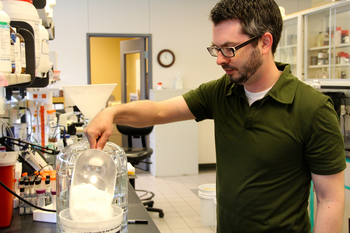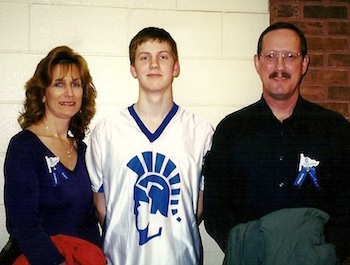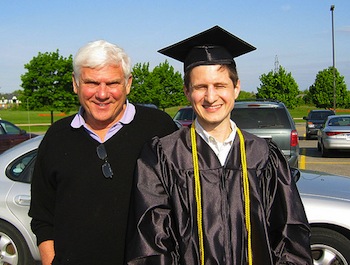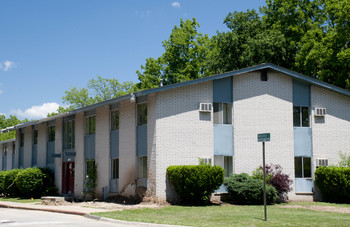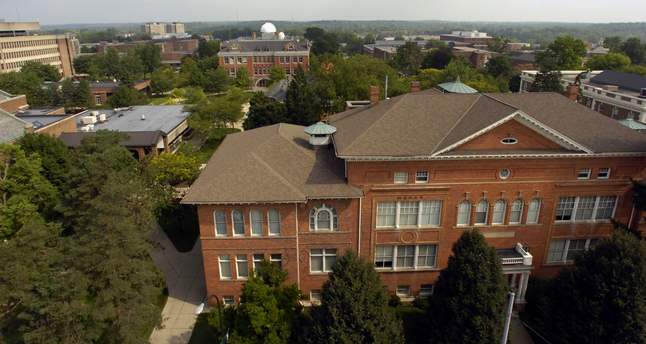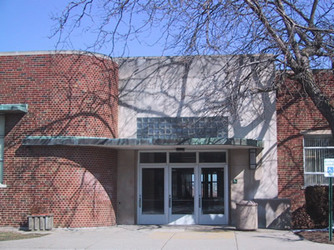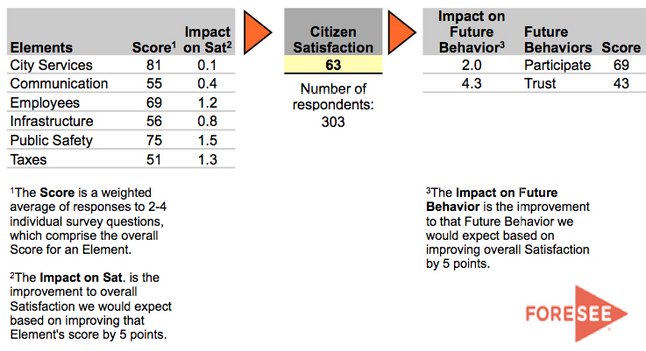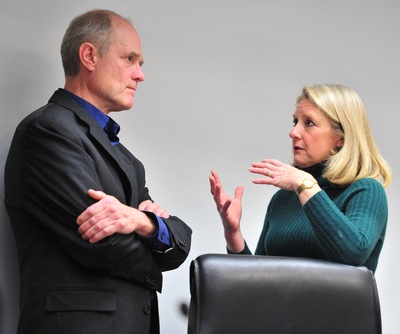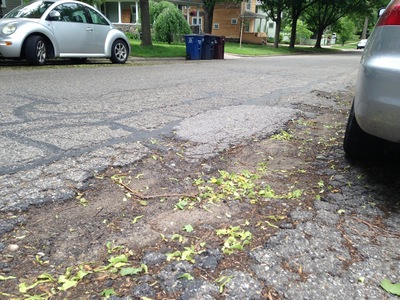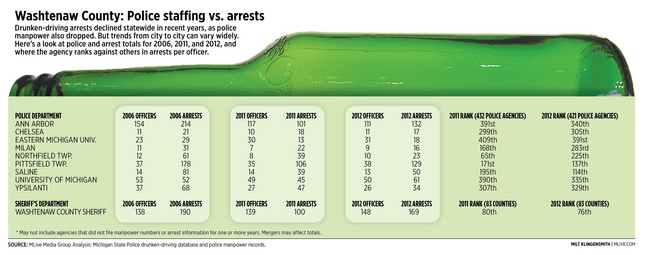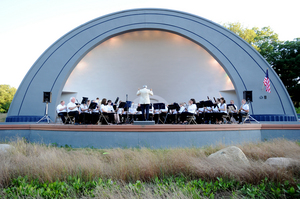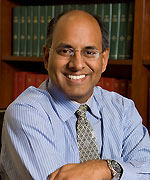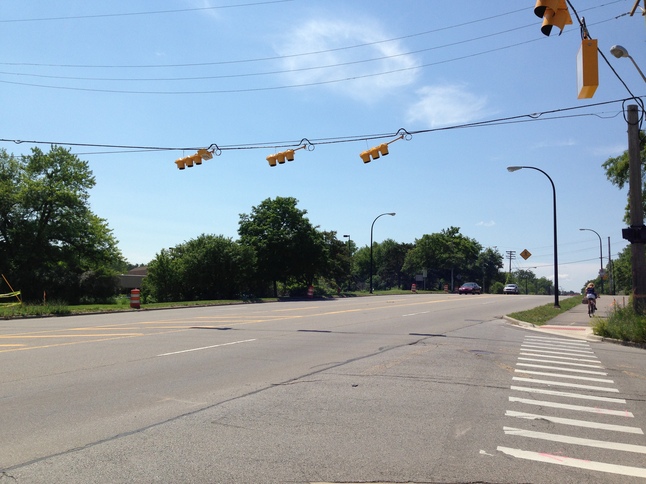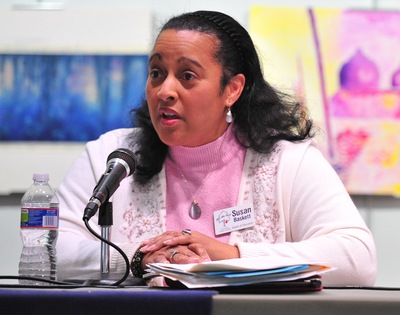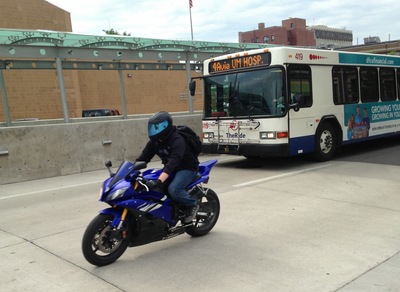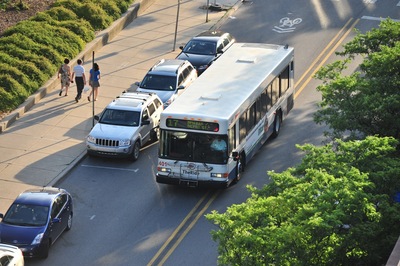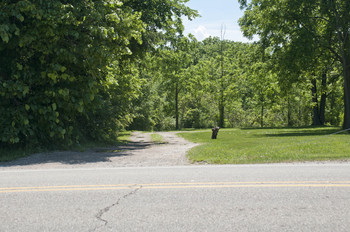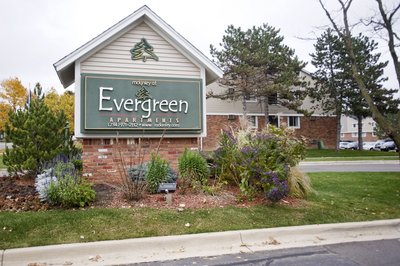The Ann Arbor school board might have avoided eliminating high school bus services for next school year, but longtime board member Susan Baskett says the issue isn't over yet.
Baskett, who recently was appointed to the Ann Arbor Transportation Authority's governing board, expects serious talks over the next year about the possibility of the school district cutting bus services and seeing where the AATA might be able to step in to fill the void.
![Susan_Baskett_LWV_022712_RJS_001.jpg]()
Ann Arbor school board member Susan Baskett at a forum last year. She now also serves on the governing board of the Ann Arbor Transportation Authority.
Ryan J. Stanton | AnnArbor.com
She also argues it wouldn't be the end of the world if some students had to walk to school and get a little more exercise.
Baskett sat down with AnnArbor.com to talk about what she sees as the next steps for both the AATA and Ann Arbor Public Schools around transportation.
AnnArbor.com: When it was decided by the school board to put transportation cuts on hold for this coming year, was it your thinking that the issue will come back around next budget cycle?
Baskett: Oh yeah.
AnnArbor.com: Is this next year then a planning year to figure out how the AATA could step up and fill the void if school bus services are eliminated?
Baskett: Absolutely. I mean, one of the things we had talked about — and I was quoted on this before — was, 'OK, if we're going to cut transportation, let's just do it all at once.' Now, I wasn't saying this year. And it was basically a statement to give my colleagues a heads up what is possible.
As I look at the resumes of the new superintendent candidates, that's one of the things I'm going to be looking for — collaboration across government.
AnnArbor.com: There are some parents out there in the community who think it's crazy to even talk about cutting busing for students. You've said you would be willing to entirely eliminate transportation for all grades K-12. Why do you think that's a good idea?
Baskett: Cost. I mean, that's it. Cost.
Because remember we tried — or we did — the consolidation with WISD. The consolidation was to help our then school bus drivers — they knew our routes, they knew our children, we knew them. What happened when we consolidated with WISD? The majority of them did not get hired.
I can always tell the start of the school year now, because I live in a neighborhood with a lot of children. I see the big yellow bus go up and down past my house five times with some guy with a piece of paper and he is obviously lost. It's a new bus driver who doesn't know where the heck he's supposed to pick up these kids, because the turnover at the WISD has just been ridiculous.
So it's a managerial issue. We can't sustain the current model. We don't have the funds to even do something totally different like privatize completely. We've got to do something in collaboration that makes sense for the long haul. We don't want to be visiting transportation every single year.
![051712_schoolbusing.JPG]()
Will school buses in Ann Arbor become a thing of the past?
Are you aware of another community where the local municipal transit system has stepped up to do busing for students in the manner you're talking about?
Baskett: No, but from what I've learned, the AATA, being a mass transit authority, they cannot get into the business of being a new school bus system. It has to be public transportation for all. But I have heard of stories of classmates getting on the bus in big cities in California, for example — 12-year-olds taking three buses to get to school. I have friends from New York where they would talk about a 45-minute subway ride to get to school, so it's not impossible.
AnnArbor.com: Under what scenarios do you think the AATA could realistically help fill the void of lost school bus services? How would that look or work in practice?
Baskett: We have worked with them this past year. We have at least two bus routes, maybe three, where AATA does fill the void of transportation. We have a relationship, for example, where the kids after seventh hour at Pioneer High — we gave them bus passes, which they can even use on the weekends. It doesn't have to be school-related. As I understand, the kids and the parents love it. It frees them up, assures them of being able to get on the bus, so I'd like to see more of that. The issue — the big concern — of course, is for those areas that are not on AATA bus routes.
AnnArbor.com: So you're thinking more of that could work — where AATA routes and services are planned with students in mind as part of the overall picture?
Baskett: Yeah.
AnnArbor.com: I'm told legally the school district can't be involved in organizing alternative transportation for students. Is this something you'll be able to work on in your dual role?
Baskett: Probably so, but I guess I need to understand more of the legal boundaries, because we have had a committee. Trustees Simone Lightfoot and Glenn Nelson have served on this transportation committee the last year with AATA, and that's how they come up to identifying the need, quantifying the need, and possible solutions.
Moving forward, I'm hoping that Trustees Lightfoot and Nelson will be able to continue that relationship since they already know the cast of characters, and I can assist from an outside perspective as well. As I understand it, we can't help negotiate the fees or collect money for the entity, but I think it's OK to discuss the issues.
![AATA_bus_061213_RJS_001.jpg]()
A biker zips past an AATA bus on Fifth Avenue in downtown Ann Arbor.
Ryan J. Stanton | AnnArbor.com
Are you getting any pushback?
Baskett: When we did this last transportation thing with the schools and we were looking at how to partner with AATA, we got some crazy emails from concerned parents who were like, 'I don't want my child on an unsafe public transit.' And I'm like, I've never seen an issue.
The buses are clean. They stick pretty much to their schedule. This fear of kids being lost on some public mass transit was just comical to me. So, from the AATA perspective, we have to make clear that we are one of the best in the nation. From the school board perspective, we have to make clear that AATA is a safe alternative. So there's some marketing to do on both sides.
AnnArbor.com: Your appointment to the AATA board by Mayor John Hieftje and the Ann Arbor City Council comes at a very interesting time considering the talks around cutting transportation at the school district level. Is this just coincidence or is there more to the story?
Baskett: It is coincidence. When I first got interested in anything mass transit, it was after attending one of the community meetings (for the AATA's countywide transit planning process) and looking at the transit master plan. I had applied to be on the multi-jurisdictional entity that went down in flames — the whole countywide thing. So I was looking to do it way before.
AnnArbor.com: Why do you want to serve on the AATA board?
Baskett: To bring to life this vision. I like that we're looking at making mass transit more than a need, but a choice. It's just a desire to be helpful.
When you look at the transit master plan and you look at the need locally, I feel I have to do something to make it happen, because the need will always be there, whether it's for high school kids or the mom trying to get her kid to the pediatrician.
AnnArbor.com: What's been your experience with riding AATA buses here in Ann Arbor? How often do you use the local transit service?
Baskett: I have used it as a consumer, but currently the system is not set up for people like me. For example, last night after a long meeting, I would have liked to just get on a bus and go home and vegetate, but there are no buses at that particular hour.
![AATA_bus_on_liberty_street_RJS.jpg]()
An AATA bus drives down Liberty Street in Ann Arbor last summer.
Ryan J. Stanton | AnnArbor.com
I live on the southeast side of Ann Arbor. If I want to go to Meijer, I have to wait an hour, so it's not yet user-friendly for me. I want to make it more user-friendly.
AnnArbor.com: Are you in favor of raising taxes to expand AATA services in the urban core, whether that just includes Ann Arbor and Ypsilanti or some larger urban core footprint?
Baskett: One thing I've learned is you've got to have money. So if that's what it takes, yeah. As I understand, the fares don't sustain the system. It's with municipal support.
AnnArbor.com: What do you make of the move to welcome Ypsilanti into the authority to create a new Ann Arbor Area Transportation Authority?
Baskett: At initial blush, it makes sense — they have a need, they're bringing in some money — but Ypsilanti already has this purchase-of-service agreement with AATA, so I'm trying to learn what is the advantage for AATA. I understand Ypsilanti's advantage.
AnnArbor.com: So it sounds like you have some reservations? Is it just that you're trying to make sure you're looking out for Ann Arbor's interests?
Baskett: Selfishly, I grew up in Ann Arbor, so Ann Arbor is all that for me. The control —Â it's my transit authority. I'm the Ann Arbor resident. Would I want an outside entity that brings a limited amount of funds and will be asking for more — do I want them necessarily co-opting expanded services that I would have in Ann Arbor? Then is that a precedence for others?
Because I would hope AATA would expand the model and invite other people in. If Ann Arbor is to pay the bulk of the services, would I necessarily want to be obligated or potentially lose control to other parties at the table? I'm still feeling that one through.
AnnArbor.com: What direction would you like to see the AATA go in the next 5 to 10 years? What projects or initiatives would you like to see come to fruition?
Baskett: I'm very intrigued with the whole master plan. I would love it so mass transit — the AATA — is my transportation of choice, and if I choose to I can get to wherever I want to go without having to use my personal car at $4 a gallon for gas. I would like to see places like Roberto Clemente and Textile — those neighborhoods — have at least a bus stop as an option.
We see students coming from neighborhoods that not only don't have bus stops, they don't have sidewalks, so they can't even walk safely. I want to be able to say that AATA can get you from wherever you are to wherever you want to go.
AnnArbor.com: So you subscribe to the philosophy that public transit in Ann Arbor should be able to serve as a substitute for owning a car?
Baskett: I do. Absolutely. It's getting more costly to own a car. I can't tell you how many of my friends' children who are 16 and 17 don't even think about getting a driver's license. That was a rite of passage for my generation. Young people now don't want to be bothered with it, and if we want to have our city grow, we've got to have that option for them.
Ryan J. Stanton covers government and politics for AnnArbor.com. Reach him at ryanstanton@annarbor.com or 734-623-2529. You also can follow him on Twitter or subscribe to AnnArbor.com's email newsletters.


